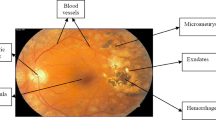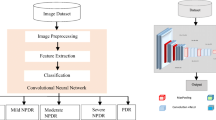Abstract
The objective of this study is to propose an alternative, hybrid solution method for diagnosing diabetic retinopathy from retinal fundus images. In detail, the hybrid method is based on using both image processing and deep learning for improved results. In medical image processing, reliable diabetic retinopathy detection from digital fundus images is known as an open problem and needs alternative solutions to be developed. In this context, manual interpretation of retinal fundus images requires the magnitude of work, expertise, and over-processing time. So, doctors need support from imaging and computer vision systems and the next step is widely associated with use of intelligent diagnosis systems. The solution method proposed in this study includes employment of image processing with histogram equalization, and the contrast limited adaptive histogram equalization techniques. Next, the diagnosis is performed by the classification of a convolutional neural network. The method was validated using 400 retinal fundus images within the MESSIDOR database, and average values for different performance evaluation parameters were obtained as accuracy 97%, sensitivity (recall) 94%, specificity 98%, precision 94%, FScore 94%, and GMean 95%. In addition to those results, a general comparison of with some previously carried out studies has also shown that the introduced method is efficient and successful enough at diagnosing diabetic retinopathy from retinal fundus images. By employing the related image processing techniques and deep learning for diagnosing diabetic retinopathy, the proposed method and the research results are valuable contributions to the associated literature.










Similar content being viewed by others
References
World Health Organization and International Diabetes Federation (2005) Definition and diagnosis of diabetes mellitus and intermediate hyperglycemia, a report of world health organization and international diabetes federation
International diabetes federation (2013) Diabetes atlas, 6th edn. Brussels, Belgium https://www.idf.org/sites/default/files/EN_6E_Atlas_Full_0.pdf. Accessed 23 Jan 2018
International diabetes federation (2009) Diabetes atlas, 4th edn. Brussels, Belgium. https://www.idf.org/sites/default/files/IDF-Diabetes-Atlas-4th-edition.pdf. Accessed 23 June 2018
Bloom DE, Cafiero E, Jané-Llopis E, Abrahams-Gessel S, Bloom LR, Fathima S et al (2012) The global economic burden of noncommunicable diseases (No. 8712). Program on the global demography of aging
Scully T (2012) Diabetes in numbers. Nature 485(7398):S2
Chase HP, Maahs DM (2011) A first book for understanding diabetes. Children’s Diabetes Foundation at Denver, Colorado
Johnstone MT, Veves A (eds) (2005) Diabetes and cardiovascular disease. Springer Science & Business Media, New York
Veresiu AI, Bondor CI, Florea B, Vinik EJ, Vinik AI, Gâvan NA (2015) Detection of undisclosed neuropathy and assessment of its impact on quality of life: a survey in 25,000 Romanian patients with diabetes. J Diabetes Complications 29(5):644–649
Congdon NG, Friedman DS, Lietman T (2003) Important causes of visual impairment in the world today. JAMA 290(15):2057–2060
Taylor HR, Keeffe JE (2001) World blindness: a 21st century perspective. Br J Ophthalmol 85(3):261–266
Kaji Y (2018) Diabetic eye disease. diabetes and aging-related complications. Springer, Singapore, pp 19–29
Antal B, Hajdu A (2012) An ensemble-based system for microaneurysm detection and diabetic retinopathy grading. IEEE Trans Biomed Eng 59(6):1720
Islam M, Dinh AV, Wahid KA (2017) Automated diabetic retinopathy detection using bag of words approach. J Biomed Sci Eng 10:86–96
Sutton J, Mahajan R, Akbilgic O, Kamaleswaran R (2018) PhysOnline: an online feature extraction and machine learning pipeline for real-time analysis of streaming physiological data. IEEE J Biomed Health Inf 10:11–12. https://doi.org/10.1109/jbhi.2018.2832610
Gencer C, Coskun A (2005) Robust speed control of permanent magnet synchronous motors using adaptive neuro fuzzy inference system controllers. Asian J Inf Technol 4(10):918–919
Kose U, Arslan A (2017) Optimization of self-learning in Computer Engineering courses: an intelligent software system supported by artificial neural network and vortex optimization algorithm. Comput Appl Eng Educ 25(1):142–156
Coskun A (2011) Optimization of a mini-golf game using the genetic algorithm. Electron Electr Eng 3(109):97–100
Coskun A, Horat B (2014) Mobese placement optimization within ankara by using genetic algorithms. Sci Res Essays 9(16):716–721
Coskun A (2016) Edge detection using ant colony optimization with specific images. Int J Res Advent Technol 4(12):2016
Coskun A, Yilmaz Y (2017) Bone age assessment with fuzzy logic. RA J Appl Res 3(12):2017
Coskun A, Arici N (2011) Defining the possible molecular structure of the drug to be penetrated through skin layers using genetic algorithm. Gazi Univ J Sci 24(2):2011
Malta TM, Sokolov A, Gentles AJ, Burzykowski T, Poisson L, Weinstein JN et al (2018) Machine learning identifies stemness features associated with oncogenic dedifferentiation. Cell 173(2):338–354
Coskun A (2011) Simulated annealing algorithm and layout optimization for the contents of a web page. In: 3rd international conference on electronics computer technology
Hussein AF, ArunKumar N, Ramirez-Gonzalez G, Abdulhay E, Tavares JMR, de Albuquerque VHC (2018) A medical records managing and securing blockchain based system supported by a genetic algorithm and discrete wavelet transform. Cogn Syst Res 52:1–11
Atanasov P, Gauthier A, Lopes R (2018) Applications of artificial intelligence technologies in healthcare: a systematic literature review. Value Health 21:S84
Wartman SA, Combs CD (2017) Medical education must move from the information age to the age of artificial intelligence. Acad Med 93:1107–1109
Hamet P, Tremblay J (2017) Artificial intelligence in medicine. Metabolism 69:S36–S40
Xing L, Krupinski EA, Cai J (2018) Artificial intelligence will soon change the landscape of medical physics research and practice. Med Phys 45(5):1791–1793
Gupta D, Sundaram S, Khanna A, Hassanien AE, de Albuquerque VHC (2018) Improved diagnosis of Parkinson’s disease using optimized crow search algorithm. Comput Electr Eng 68:412–424
Gupta D, Julka A, Jain S, Aggarwal T, Khanna A, Arunkumar N, de Albuquerque VHC (2018) Optimized cuttlefish algorithm for diagnosis of Parkinson’s disease. Cogn Syst Res 52:36–48
Hemanth JD, Kose U, Deperlioglu O, de Albuquerque VHC (2018) An augmented reality-supported mobile application for diagnosis of heart diseases. J Supercomput. https://doi.org/10.1007/s11227-018-2483-6
Moreira MW, Rodrigues JJ, Al-Muhtadi J, Korotaev VV, de Albuquerque VHC (2018) Neuro-fuzzy model for HELLP syndrome prediction in mobile cloud computing environments. Concurr Comput. https://doi.org/10.1002/cpe.4651
Peixoto SA, Rebouças Filho PP, Kumar NA, de Albuquerque VHC (2018) Automatic classification of pulmonary diseases using a structural co-occurrence matrix. Neural Comput Appl. https://doi.org/10.1007/s00521-018-3736-2
Pereira CR, Pereira DR, Rosa GH, Albuquerque VH, Weber SA, Hook C, Papa JP (2018) Handwritten dynamics assessment through convolutional neural networks: an application to Parkinson’s disease identification. Artif Intell Med 87:67–77
Kakillioglu B, Sharma R, Jindal V (2015) Diabetes diagnosis by machine learning using acquired data set, project report, Syracuse University
Rebouças Filho PP, Peixoto SA, da Nóbrega RVM, Hemanth DJ, Medeiros AG, Sangaiah AK, de Albuquerque VHC (2018) Automatic histologically-closer classification of skin lesions. Comput Med Imaging Graph 68:40–54
Rebouças EDS, Marques RC, Braga AM, Oliveira SA, de Albuquerque VHC, Rebouças Filho PP (2018) New level set approach based on Parzen estimation for stroke segmentation in skull CT images. Soft Comput. https://doi.org/10.1007/s00500-018-3491-4
Reboucas Filho PP, Reboucas EDS, Marinho LB, Sarmento RM, Tavares JMR, de Albuquerque VHC (2017) Analysis of human tissue densities: a new approach to extract features from medical images. Pattern Recogn Lett 94:211–218
Rodrigues MB, Da Nóbrega RVM, Alves SSA, Rebouças Filho PP, Duarte JBF, Sangaiah AK, De Albuquerque VHC (2018) Health of things algorithms for malignancy level classification of lung nodules. IEEE Access 6:18592–18601
Rebouças Filho PP, Cortez PC, da Silva Barros AC, Albuquerque VHC, Tavares JMR (2017) Novel and powerful 3D adaptive crisp active contour method applied in the segmentation of CT lung images. Med Image Anal 35:503–516
Rebouças Filho PP, da Silva Barros AC, Ramalho GL, Pereira CR, Papa JP, de Albuquerque VHC, Tavares JMR (2017) Automated recognition of lung diseases in CT images based on the optimum-path forest classifier. Neural Comput Appl. https://doi.org/10.1007/s00521-017-3048-y
Seoud L, Chelbi J, Cheriet F (2015) Automatic grading of diabetic retinopathy on a public database. In: Chen X, Garvin MK, Liu JJ, Trusso E, Xu Y (eds) Proceedings of the ophthalmic medical image analysis second international workshop, OMIA 2015, pp 97–104
Savarkar SP, Kalkar N, Tade SL (2013) Diabetic retinopathy using image processing detection, classification and analysis. Int J Adv Comput Res 3(3):285
Sreejini KS, Govindan VK (2013) Severity grading of DME from retina images: a combination of PSO and FCM with bayes classifier. Int J Comput Appl 81(16):11–17
Safitri DW, Juniati D (2017) Classification of diabetic retinopathy using fractal dimension analysis of eye fundus image. In: AIP conference proceedings, vol 1867, No. 1, p 020011. AIP Publishing
Akram MU, Khalid S, Khan SA (2013) Identification and classification of microaneurysms for early detection of diabetic retinopathy. Pattern Recogn 46(1):107–116
Acharya UR, Ng EYK, Tan JH, Sree SV, Ng KH (2012) An integrated index for the identification of diabetic retinopathy stages using texture parameters. J Med Syst 36(3):2011–2020
Lim ST, Zaki WMDW, Hussain A, Lim SL, Kusalavan S (2011) Automatic classification of diabetic macular edema in digital fundus images. In: IEEE colloquium on humanities, science and engineering (CHUSER), 2011, pp 265–269
Agurto C, Murray V, Barriga E, Murillo S, Pattichis M, Davis H et al (2010) Multiscale AM-FM methods for diabetic retinopathy lesion detection. IEEE Trans Med Imaging 29(2):502–512
Chandrayan P (2017) Deep learning: autoencoders fundamentals and types. CodeBurst.IO. https://codeburst.io/deep-learning-types-and-autoencoders-a40ee6754663. Accessed 27 June 2018
Chicco D, Sadowski P, Baldi P (2014) Deep autoencoder neural networks for gene ontology annotation predictions. In: Proceedings of the 5th ACM conference on bioinformatics, computational biology, and health informatics, pp 533–540. ACM
Klein JC, Menard M, Cazuguel G, Fernandez-Maloigne C, Shaefer G, Gain P et al (2016) Methods to evaluate segmentation and indexing techniques in the field of retinal ophthalmology (MESSIDOR). Ecole des Mines de Paris
Decencière E, Zhang X, Cazuguel G, Lay B, Cochener B, Trone C et al (2014) Feedback on a publicly distributed image database: the Messidor database. Image Anal Stereol 33(3):231–234
Singh B, Mishra RS, Gour P (2011) Analysis of contrast enhancement techniques for underwater image. Int J Comput Technol Electron Eng 1(2):190–194
Kassab A (2012) Image enhancement methods and implementation in MATLAB, Bachelor of Science Thesis, University of West Bohemia
Deperlioglu O, Kose U, Guraksin GE (2018) Underwater image enhancement with HSV and histogram equalization. In: International conference on advanced technologies 2018 (ICAT 2018), Antalya, Turkey
MathWorks (2018) Image enhancement by histogram equalization. MathWorks documentation. https://it.mathworks.com/help/hdlcoder/examples/image-enhancement-by-histogram-equalization.html. Accessed 1 Dec 2018
Kaur T, Sidhu RK (2015) Performance evaluation of fuzzy and histogram based color image enhancement. Procedia Comput Sci 58:470–477
Beohar R, Sahu P (2013) Performance analysis of underwater image enhancement with CLAHE 2D median filtering technique on the basis of SNR, RMS error, mean brightness. Int J Eng Innov Technol 3(2):525–528
Yussof WNJHW, Hitam MS, Awalludin EA, Bachok Z (2013) Performing contrast limited adaptive histogram equalization technique on combined color models for underwater image enhancement. Int J Interact Digit Media 1(1):1–6
Huang Y (2013) Image color correction and contrast enhancement. SlideShare.Net. https://www.slideshare.net/yuhuang/image-color-correction-contrast-adjustment. Accessed 30 Nov 2018
Goodfellow I, Bengio Y, Courville A, Bengio Y (2016) Deep learning. MIT Press, Cambridge
Sze V, Chen YH, Yang TJ, Emer JS (2017) Efficient processing of deep neural networks: a tutorial and survey. Proc IEEE 105(12):2295–2329
LISA Lab (2018) Convolutional neural networks (LeNet). DeepLearning.Net Documentation. http://deeplearning.net/tutorial/lenet.html. Accessed 27 June 2018
Deperlioglu O (2018) Classification of phonocardiograms with convolutional neural networks. Brain 9(2):22–33
Sudha LR, Thirupurasundari S (2014) Analysis and detection of haemorrhages and exudates in retinal images. Int J Sci Res Publ 4(3):1
Ramachandran N, Hong SC, Sime MJ, Wilson GA (2018) Diabetic retinopathy screening using deep neural network. Clin Exp Ophthalmol 46(4):412–416
Lin GM, Chen MJ, Yeh CH, Lin YY, Kuo HY, Lin MH et al (2018) Transforming retinal photographs to entropy images in deep learning to improve automated detection for diabetic retinopathy. J Ophthalmol. 2018:2159702. https://doi.org/10.1155/2018/2159702
Aujih AB, Izhar LI, Mériaudeau F, Shapiai MI (2018) Analysis of retinal vessel segmentation with deep learning and its effect on diabetic retinopathy classification. In: 2018 International conference on intelligent and advanced system (ICIAS), pp 1–6. IEEE
Author information
Authors and Affiliations
Corresponding author
Additional information
Publisher's Note
Springer Nature remains neutral with regard to jurisdictional claims in published maps and institutional affiliations.
Rights and permissions
About this article
Cite this article
Hemanth, D.J., Deperlioglu, O. & Kose, U. An enhanced diabetic retinopathy detection and classification approach using deep convolutional neural network. Neural Comput & Applic 32, 707–721 (2020). https://doi.org/10.1007/s00521-018-03974-0
Received:
Accepted:
Published:
Issue Date:
DOI: https://doi.org/10.1007/s00521-018-03974-0




